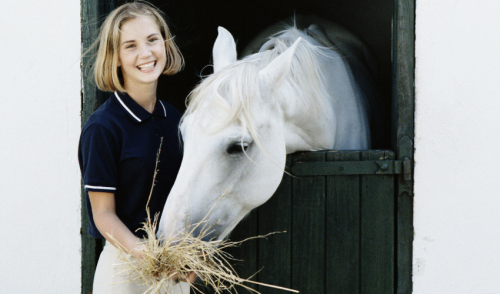{article.name}
Switching Horse Feeds Safely

- Share this:
- Share on Facebook
- Pin on Pinterest
- Tweet on Twitter
Your horse’s dietary needs will change throughout its life, but it can be tricky to switch horse feeds safely without stressing the animal or causing digestive upsets or nutritional imbalances. With the proper steps to change diets, however, you can minimize any problems and keep your horse well-fed.
Why You May Need to Switch Horse Feeds
There are many reasons why it may be necessary to change your horse’s feed. As the animal grows and matures, it will need a different diet – the nutritional needs of a foal are much different than that of a horse in its prime or of a senior animal that may need some joint help or other specialized feed. Other factors that impact the feed your horse will need include…
- Pasture Quality: Since different fields have different compositions, if your horse moves to a new pasture, its feed may need to change to compensate for grazing changes.
- Breeding Status: A pregnant or nursing mare will need better quality feed or feed supplements in order to nourish her foal for proper growth.
- Workload: A working horse needs different nutrition when it is more heavily active than when it is less active in winter. This also applies to show horses during show seasons.
- Seasons: Horses need better nutrition in winter in order to get suitable calories to stay warm. Likewise, feed may need to change in different climates to compensate for local weather.
- Disease: If your horse contracts a disease or develops a health condition such as arthritis, changing the feed can help alleviate the symptoms and promote healing.
- Supplier Changes: Feed suppliers occasionally change the feed they sell, or your supplier may go out of business and you have no option but to change your horse’s feed.
- Budget: If your personal budget or financial circumstances change, you may need to switch feeds to something more affordable.
- Moving: If you move, your horse may experience a number of changes at once, including pasture and climate. Changing their feed can help keep them nutritionally balanced.
How to Safely Change Your Horse’s Feed
Whatever the reason for changing your horse’s feed, the key to safely making dietary adjustments is to do it gradually. Before you change the feed, however, consult with your veterinarian to assess your horse’s shifting nutritional needs to be sure you choose a new feed that will be healthy and suitable.
When you have selected a new feed, slowly introduce it to your horse’s meals, starting with only 10-20 percent of the new feed mixed with their more familiar feed. Each day you can slowly change the proportions, gradually switching to more and more of the new feed. Another option is to switch up to 25 percent of the feed at once, but keep that same ratio for several days before then switching to a 50:50 mix, and then to 75 percent new feed with only 25 percent of the old feed.
Ultimately, it should take at least 7-10 days to completely switch your horse’s feed. If your animal has a sensitive stomach or is subject to food allergies, however, you may want to progress even more slowly and take 2-4 weeks to completely shift to a new feed. If at any time your horse reacts poorly to the change with colic, diarrhea, or appetite loss, hold off any further changes for a few days until they have settled down. If necessary, shift slightly back to the more familiar feed, but do not eliminate the new feed entirely or you will need to start the transition process all over again.
It may be necessary to change your horse’s feed several times in their lifetime, for a number of different reasons. If you know how to transition between feeds carefully and safely, your horse will get the proper nutrition without any unpleasant complications.
Special Offers
We are constantly adding new specials to our site. Be sure to check back often!


Comments